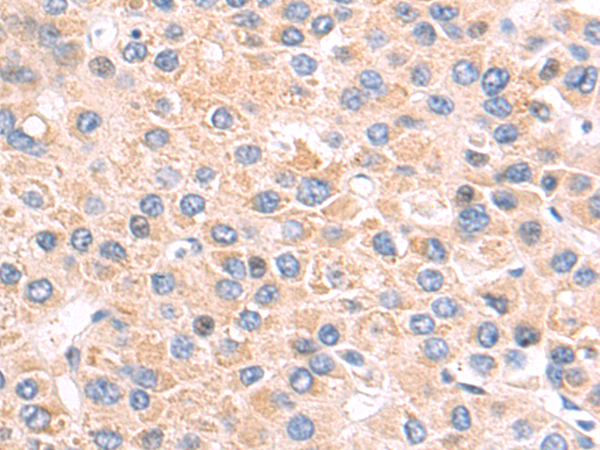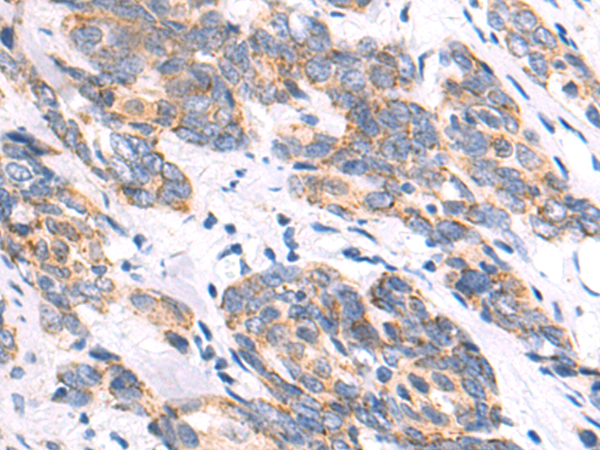


| WB | 咨询技术 | Human,Mouse,Rat |
| IF | 咨询技术 | Human,Mouse,Rat |
| IHC | 1/50-1/200 | Human,Mouse,Rat |
| ICC | 技术咨询 | Human,Mouse,Rat |
| FCM | 咨询技术 | Human,Mouse,Rat |
| Elisa | 1/5000-1/10000 | Human,Mouse,Rat |
| Aliases | FXR1P; MYOPMIL; MYORIBF |
| WB Predicted band size | 70 kDa |
| Host/Isotype | Rabbit IgG |
| Antibody Type | Primary antibody |
| Storage | Store at 4°C short term. Aliquot and store at -20°C long term. Avoid freeze/thaw cycles. |
| Species Reactivity | Human, Mouse, Rat |
| Immunogen | Synthetic peptide of human FXR1 |
| Formulation | Purified antibody in PBS with 0.05% sodium azide and 50% glycerol. |
+ +
以下是关于FXR1抗体的3篇代表性文献,包含文献名称、作者及摘要概括:
---
1. **文献名称**:*FXR1 is an IL-19-induced RNA-binding protein that alleviates septic shock by antagonizing NF-κB activation*
**作者**:Li Y, et al.
**摘要**:该研究揭示了FXR1在炎症反应中的调控作用,利用特异性抗体检测发现FXR1通过结合IL-19 mRNA抑制NF-κB信号通路,从而减轻脓毒症休克。研究强调了FXR1抗体在炎症模型中的功能验证价值。
---
2. **文献名称**:*FXR1 regulates DNA damage response and cisplatin resistance by controlling the translation of BRCA1*
**作者**:Phatnani HP, et al.
**摘要**:通过免疫沉淀(IP)结合FXR1抗体,研究发现FXR1通过调控BRCA1的翻译影响DNA修复机制,其表达缺失导致卵巢癌细胞对顺铂耐药。抗体实验证实了FXR1与DNA损伤修复蛋白的相互作用。
---
3. **文献名称**:*FXR1 promotes cancer cell stemness by stabilizing SOX2 mRNA in hepatocellular carcinoma*
**作者**:Wang X, et al.
**摘要**:研究利用FXR1抗体进行免疫组化(IHC)和Western blot分析,发现FXR1通过稳定SOX2 mRNA增强肝癌干细胞特性,靶向FXR1可抑制肿瘤生长,为肝癌治疗提供新靶点。
---
4. **文献名称**:*FXR1 is a novel RNA-binding protein that interacts with fragile X-related protein family members*
**作者**:Darnell JC, et al.
**摘要**:该研究开发了针对FXR1的特异性抗体,通过免疫荧光和共定位实验揭示FXR1与FMRP、FXR2在神经元中的协同作用,为脆性X综合征相关机制研究提供了工具支持。
---
这些文献覆盖了FXR1在癌症、炎症、神经疾病中的功能及抗体应用,可作为研究FXR1的起点。如需具体实验细节或DOI,可进一步补充检索。
FXR1 (Fragile X Mental Retardation Syndrome-Related Protein 1) is an RNA-binding protein belonging to the FXR family, which includes FXR2 and FMR1 (FMRP). These proteins regulate translation and stability of target mRNAs, particularly in neuronal and muscular tissues. FXR1 plays critical roles in embryonic development, muscle function, and cellular stress responses. It forms complexes with other RNA-binding proteins, such as CYFIP2. to modulate mRNA transport and localized translation. Dysregulation of FXR1 is implicated in neurodevelopmental disorders, muscular dystrophies, and cancers, where it may influence tumor progression via mRNA metabolism pathways.
FXR1 antibodies are essential tools for studying its expression, localization, and molecular interactions. They are widely used in techniques like Western blotting, immunofluorescence, and immunoprecipitation to investigate FXR1's role in cellular processes. Researchers employ these antibodies to explore tissue-specific expression patterns, particularly in muscle and brain, and to identify post-translational modifications affecting FXR1 function. Some antibodies target specific isoforms generated through alternative splicing, enabling studies on isoform-specific activities. Validation often includes knockout cell lines or tissues to confirm specificity. Commercial FXR1 antibodies are typically raised against conserved regions (e.g., N-terminal or C-terminal epitopes) across multiple species, facilitating cross-species research. Recent studies using these antibodies have revealed FXR1's involvement in cancer cell invasion, neuromuscular junction maintenance, and viral RNA regulation, highlighting its diverse pathophysiological significance.
×